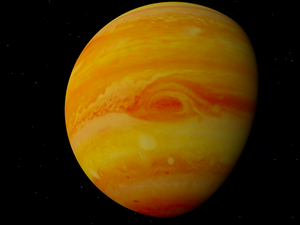55 Cancri b
| Exoplanet | List of exoplanets | |
|---|---|---|
 |
||
| Parent star | ||
| Star | 55 Cancri A | |
| Constellation | Cancer | |
| Right ascension | (α) | 08h 52m 35.8s |
| Declination | (δ) | +28° 19′ 51″ |
| Apparent magnitude | (mV) | 5.95 |
| Distance | 40.3 ± 0.4 ly (12.3 ± 0.1 pc) |
|
| Spectral type | G8V | |
| Mass | (m) | 0.95 ± 0.10 M☉ |
| Radius | (r) | 1.152 ± 0.035 R☉ |
| Temperature | (T) | 5373 ± 9.7 K |
| Metallicity | [Fe/H] | 0.29 |
| Age | 7.4–8.7 Gyr | |
| Orbital elements | ||
| Semi-major axis | (a) | 0.115 ± 0.0000011AU (17.2 Gm) |
| 9.18 mas | ||
| Periastron | (q) | 0.113 AU (16.9 Gm) |
| Apastron | (Q) | 0.116 AU (17.4 Gm) |
| Eccentricity | (e) | 0.014 ± 0.008 |
| Orbital period | (P) | 14.65162 ± 0.0007d (0.04011325 y) |
| Inclination | (i) | ~85° |
| Argument of periastron |
(ω) | 131.94 ± 30° |
| Time of periastron | (T0) | 2,450,002.94749 ± 1.2JD |
| Semi-amplitude | (K) | 71.32 ± 0.41m/s |
| Physical characteristics | ||
| Mass | (m) | 0.824 ± 0.007MJ |
| Stellar flux | (F⊙) | 48 ⊕ |
| Discovery information | ||
| Discovery date | April 12, 1996 | |
| Discoverer(s) | Butler, Marcy | |
| Discovery method | Radial velocity | |
| Other detection methods | Transit | |
| Discovery site | California, USA | |
| Discovery status | Published | |
| Other designations | ||
|
Galileo, 55 Cancri Ab, Rho1 Cancri b, HD 75732 b
|
||
| Database references | ||
| Extrasolar Planets Encyclopaedia |
data | |
| SIMBAD | data | |
| Exoplanet Archive | data | |
| Open Exoplanet Catalogue | data | |
55 Cancri b (abbreviated 55 Cnc b), occasionally designated 55 Cancri Ab (to distinguish it from the star 55 Cancri B), also named Galileo, is an exoplanet orbiting the Sun-like star 55 Cancri A every 14.65 days. It is the second planet in order of distance from its star, and is an example of a hot Jupiter, or possibly rather "warm Jupiter".
In July 2014 the International Astronomical Union launched a process for giving proper names to certain exoplanets and their host stars. The process involved public nomination and voting for the new names. In December 2015, the IAU announced the winning name was Galileo for this planet. The winning name was submitted by the Royal Netherlands Association for Meteorology and Astronomy of the Netherlands. It honors early-17th century astronomer and physicist Galileo Galilei.
55 Cancri b was discovered in 1996 by Geoffrey Marcy and R. Paul Butler. It was the fourth known extrasolar planet, excluding pulsar planets. Like the majority of known extrasolar planets, it was discovered by detecting variations in its star's radial velocity caused by the planet's gravity. By making sensitive measurements of the Doppler shift of the spectrum of 55 Cancri A, a 15-day periodicity was detected. The planet was announced in 1996, together with the planet of Tau Boötis and the innermost planet of Upsilon Andromedae.
Even when this inner planet, with a mass at least 78% times that of Jupiter was accounted for, the star still showed a drift in its radial velocity. This eventually led to the discovery of the outer planet 55 Cancri d in 2002.
...
Wikipedia
